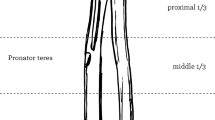Abstract
Für 460 distale Radiusfrakturen, von denen 91 operiert wurden, wird eine Bewertung des radiologischen und klinischen Therapieresultats vorgenommen. Es zeigt sich eine enge Korrelation, welche die Wichtigkeit der exakten anatomischen Reposition und Retention betont. Für Frakturformen ohne Beteiligung des Radiokarpalgelenkes mit ausgeprägter Verkippungstendenz wird die perkutane Bohrdrahtosteosynthese empfohlen. Brüche mit ausgedehnten Zertrümmerungen und Beteiligung dieses Gelenkes erweisen sich als Problemfälle. Mit Plattenosteosynthese und Fixateur externe stehen hier zwei alternative Therapiekonzepte zur Verfügung.
Abstract
460 fractures of the distal radius including 91 which are treated surgically are investigated in a retrospective study. There were 260 fractures of the left and only 200 of the right radius. 66 % of the patients were female, especially striking is the superior number of women older than 45 years. The evaluation of the final radiological results referring to anatomical joint angles and normal radius lenght shows a high correlation to the evaluation of the final functional results. 70 % of the latter are valued as excellent or good, 19 % as tolerable and 11 % as poor. The classification according to Frykman shows a significantly better result for cases without violation of the distal ulna. The comparison between operative and nonoperative treatment of dislocated fractures without infraction of the radiocarpal joint demonstrates good results of percutaneous wire fixation in those cases. The therapy of fractures with infraction of radiocarpal and radioulnar joint is difficult. In this group we could not find a superiority of operative against conservative treatment. Wire fixation lead to 19 % poor results and cannot be recommended for all cases. Six patients treated by external fixation and five treated by osteosynthesis using metal plates had good or tolerable results. The indication for using these methods has to be considered.
Similar content being viewed by others
Literatur
Clancey, G. J.: Percutaneous Kirschner-wire fixation of Colles fractures. A prospective study of thirty cases. J. Bone Jt Surs. 66-A (1954), 1008.
Erdweg, W., F. Kleinfeld: Zur Behandlung der Flexionsfrakturen am distalen Radius. Akt. Traumatol. 12 (1982), 205.
Forgon, M., E. Mammel: Unsere Korrekturosteotomie in Fehlstellung geheilter Frakturen der Speiche an typischer Stelle. Unfallchirurgie 9 (1983), 318.
Freising, S., B. Walter: Zur konservativen und operativen Behandlung der Radiusfraktur loco classico. Chirurg 54 (1983), 742.
Frykman, G.: Fracture of the distal radius including sequelae — shoulder-hand-finger syndrome, disturbance of the distal radioulnar joint and impairment of nerve funktion. A clinical and experimental study. Acta orthop. scand. Suppl. 108 (1967), 5.
Heim, U., K. M. Pfeiffer: Periphere Osteosynthesen unter Verwendung des Kleinfragment-Instrumentariums der AO. Springer, Berlin-Heidelberg-New York 1981.
Müller, M. E., M. Allgöwer, R. Schneider, H. Willenegger: Manual der Osteosynthese AO-Technik. Springer, Berlin-Heidelberg-New York 1977.
Pfeiffer, K. M., P. Lauber: Was leistet die stabile Osteosynthese am distalen Radius? Handchirurgie 16 (1984), 80.
Sagesser, M.: Spezielle chirurgische Therapie. Huber, Bern-Stuttgart-Wien 1972.
Sarmiento, A., J. B. Zagorski, W. F. Sinclair: Functional bracing of Colles’ fractures: a prospective study of immobilization in supination vs, pronation. Clin. Orthop. 146 (1980), 175.
Seiler, H., G. Omlor, A. Betz: Zur operativen Therapie bei der frischen distalen Radiusfraktur. Unfallheilkunde 84 (1981), 139.
Siggelkow, G.: Die Bohrdrahtosteosynthe.se bei der frischen distalen Radiusfraktur. Z. ärztl. Fortbild. 76 (1982), 901.
Stewart, H. D., A. R. Innes, F. D. Burke: Functional castbracing for Colles’ fractures. A comparison between castbracing and conventional plaster casts. J. Bone Jt Surg. 66-B (1984) 7749.
Thomas, F.: Reduction Smith’s fractures. J. Bone Jt Surg. 39-B (1957), 463.
Wagner, H. E., R. P. Jakob: Operative Behandlung der distalen Radiusfraktur mit Fixateur externe. Unfallchirurgie 88 (1985), 473.
Author information
Authors and Affiliations
Rights and permissions
About this article
Cite this article
Zwack, M., Kempf, P. & Stelzig, H.H. Distale radiusfraktur — Behandlungsergebnisse, indikationen zur konservativen, halboperativen und operativen therapie. Unfallchirurgie 14, 125–132 (1988). https://doi.org/10.1007/BF02806641
Received:
Accepted:
Issue Date:
DOI: https://doi.org/10.1007/BF02806641




